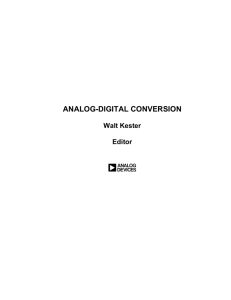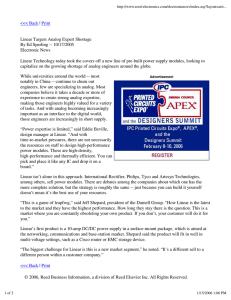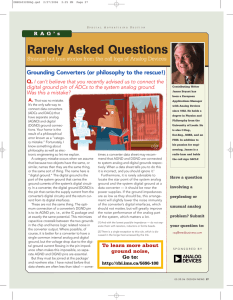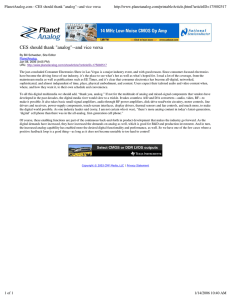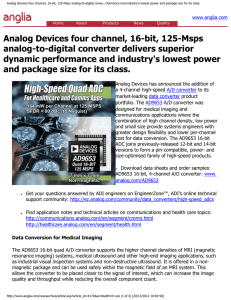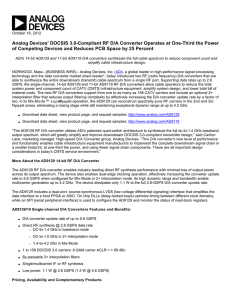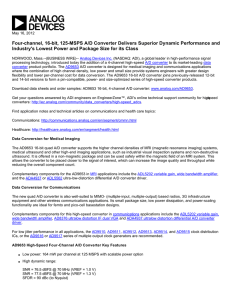Technical Article 2011 Trends in Data Conversion MS-2123
advertisement
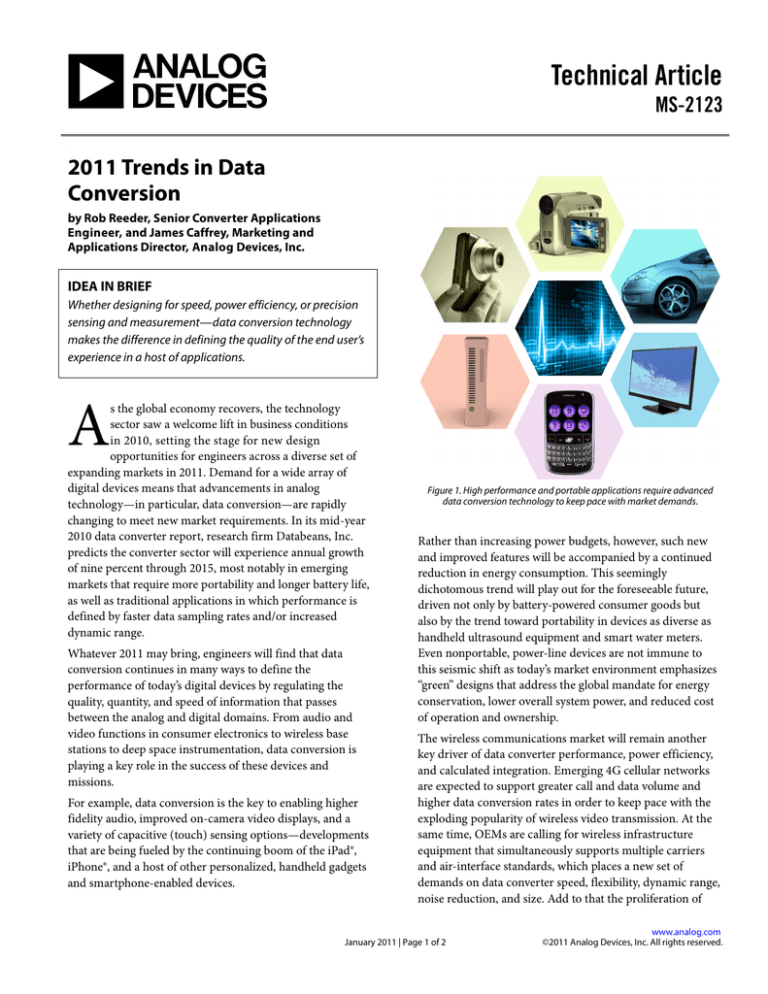
Technical Article MS-2123 . 2011 Trends in Data Conversion by Rob Reeder, Senior Converter Applications Engineer, and James Caffrey, Marketing and Applications Director, Analog Devices, Inc. IDEA IN BRIEF Whether designing for speed, power efficiency, or precision sensing and measurement—data conversion technology makes the difference in defining the quality of the end user’s experience in a host of applications. A s the global economy recovers, the technology sector saw a welcome lift in business conditions in 2010, setting the stage for new design opportunities for engineers across a diverse set of expanding markets in 2011. Demand for a wide array of digital devices means that advancements in analog technology—in particular, data conversion—are rapidly changing to meet new market requirements. In its mid-year 2010 data converter report, research firm Databeans, Inc. predicts the converter sector will experience annual growth of nine percent through 2015, most notably in emerging markets that require more portability and longer battery life, as well as traditional applications in which performance is defined by faster data sampling rates and/or increased dynamic range. Whatever 2011 may bring, engineers will find that data conversion continues in many ways to define the performance of today’s digital devices by regulating the quality, quantity, and speed of information that passes between the analog and digital domains. From audio and video functions in consumer electronics to wireless base stations to deep space instrumentation, data conversion is playing a key role in the success of these devices and missions. For example, data conversion is the key to enabling higher fidelity audio, improved on-camera video displays, and a variety of capacitive (touch) sensing options—developments that are being fueled by the continuing boom of the iPad®, iPhone®, and a host of other personalized, handheld gadgets and smartphone-enabled devices. Figure 1. High performance and portable applications require advanced data conversion technology to keep pace with market demands. Rather than increasing power budgets, however, such new and improved features will be accompanied by a continued reduction in energy consumption. This seemingly dichotomous trend will play out for the foreseeable future, driven not only by battery-powered consumer goods but also by the trend toward portability in devices as diverse as handheld ultrasound equipment and smart water meters. Even nonportable, power-line devices are not immune to this seismic shift as today’s market environment emphasizes “green” designs that address the global mandate for energy conservation, lower overall system power, and reduced cost of operation and ownership. The wireless communications market will remain another key driver of data converter performance, power efficiency, and calculated integration. Emerging 4G cellular networks are expected to support greater call and data volume and higher data conversion rates in order to keep pace with the exploding popularity of wireless video transmission. At the same time, OEMs are calling for wireless infrastructure equipment that simultaneously supports multiple carriers and air-interface standards, which places a new set of demands on data converter speed, flexibility, dynamic range, noise reduction, and size. Add to that the proliferation of January 2011 | Page 1 of 2 www.analog.com ©2011 Analog Devices, Inc. All rights reserved. MS-2123 Technical Article smaller cellular networks comprised of picocell and femtocell wireless base stations—and it’s clear that the future of high-speed converters in this market will be defined by lower power consumption combined with faster sampling rates and more usable bandwidth at higher intermediate frequencies. While the power efficiency mandate is asserting itself in markets that historically cared much more about raw data converter performance, OEMs serving the industrial, instrumentation, aerospace, and defense electronics industries additionally continue to require rugged, robust converters for applications that must withstand harsh operating environments. On one end of the spectrum, designers are looking for high performance, innovative data conversion solutions for medical, energy, communications, and other devices. On the other, engineers are unwilling to trade off on reliability, especially in industrial and scientific applications where system repairs may be difficult or impossible. The ability to provide not only the converters but to understand and recommend solutions to meet these diverse needs is increasingly important. Analog Devices, for example, collaborates with customers to provide exceptionally high data conversion accuracy in monitoring and measurement equipment that may be used in extraterrestrial exploration, as in the case of the Mars Phoenix Lander, or that are permanently buried under kilometers of South Polar ice, as with the University of Wisconsin’s IceCube Neutrino Observatory project. Regardless of the end application—whether performance is defined by speed, power efficiency, or precision sensing and measurement—data conversion technology will remain a core ingredient for defining the quality of the end user’s digital experience. RESOURCES For data converter products, tools, documentation, and training, visit www.analog.com/dataconverters. One Technology Way • P.O. Box 9106 • Norwood, MA 02062-9106, U.S.A. Tel: 781.329.4700 • Fax: 781.461.3113 • www.analog.com Trademarks and registered trademarks are the property of their respective owners. T09624-0-1/11(0) www.analog.com ©2011 Analog Devices, Inc. All rights reserved. January 2011 | Page 2 of 2
